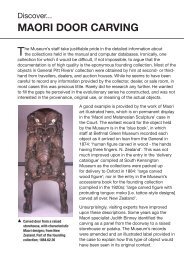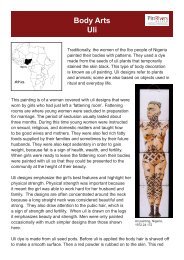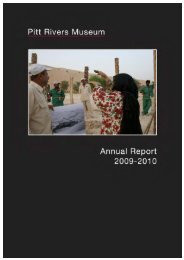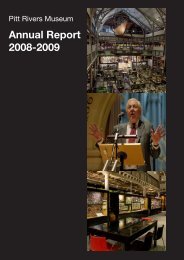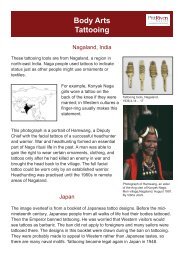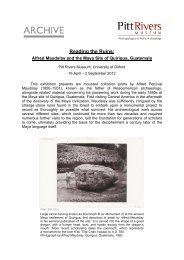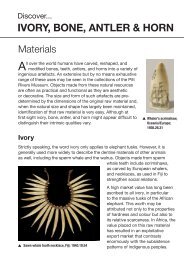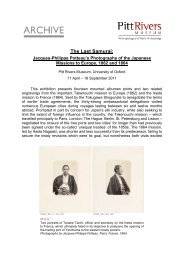Pitt Rivers Museum - University of Oxford
Pitt Rivers Museum - University of Oxford
Pitt Rivers Museum - University of Oxford
You also want an ePaper? Increase the reach of your titles
YUMPU automatically turns print PDFs into web optimized ePapers that Google loves.
DIRECTOR’S INTRODUCTION<br />
This reporting year was one <strong>of</strong> enormous activity, considerable achievement, and great<br />
sadness. The frenetic activity, <strong>of</strong> course, surrounded the construction <strong>of</strong> the <strong>Museum</strong>’s new<br />
£8,000,000 extension, which was completed during the year—and into which almost all staff<br />
had moved by the end <strong>of</strong> it. Indeed, pressure on space elsewhere within the <strong>University</strong> meant<br />
that an advance guard <strong>of</strong> staff moved into the new extension well before it was fully<br />
complete. I am very grateful to those colleagues for their equanimity in coping with noise, the<br />
comings and goings <strong>of</strong> workmen and—how can I put this while still making clear our<br />
rigorous adherence to health and safety regulations?—the odd trailing cable and less than<br />
fully completed section <strong>of</strong> flooring.<br />
One <strong>of</strong> the more complicated aspects <strong>of</strong> building the new extension was the creation <strong>of</strong><br />
its intersection with the ‘old’ galleries, this breakthrough area being the last part to be<br />
completed. It was, however, wonderful to see for the first time the fresh views into the<br />
galleries from the new extension, and to be reminded that the latter is not only a wonderful<br />
new space for teaching and research but is itself an integral part <strong>of</strong> the <strong>Museum</strong>. At the same<br />
time, a good number <strong>of</strong> the displays around the intersection with the new extension—on all<br />
three floors—had to be dismantled during the construction works. Even with the energetic<br />
efforts <strong>of</strong> the <strong>Museum</strong>’s technical services team, it will take a good many months to restore<br />
them fully.<br />
A further call on staff time associated with building the new extension was created by<br />
the need to move the collections <strong>of</strong> musical instruments and archaeological materials from<br />
the Balfour Galleries and the house at 60 Banbury Road, premises that the <strong>Museum</strong> had<br />
agreed to relinquish in return for the final tranche <strong>of</strong> funding needed to complete the new<br />
extension itself. Additional space for these collections has been found close to the <strong>Museum</strong>’s<br />
main site, but the careful packing <strong>of</strong> thousands <strong>of</strong> musical instruments and tens <strong>of</strong> thousand<br />
<strong>of</strong> flints for transport to a new location was a major task, especially when done against the<br />
clock. I am especially grateful to the <strong>Museum</strong>’s collections staff, in particular to my<br />
colleagues Heather Richardson, Marina de Alarcón, and Zena McGreevy, for their devotion<br />
to this task, and for their insistence that this should be treated not as a mere removal job, but<br />
taken as an opportunity to upgrade the storage conditions and location records <strong>of</strong> these<br />
important collections, which as a result will soon be not only closer to hand but also more<br />
readily accessible for staff and visitors.<br />
The new extension is an exceptional facility, and it has been heart-warming to see its<br />
visitor research areas starting to come into operation, led by my colleagues Chris Morton and<br />
Philip Grover, who spent a good deal <strong>of</strong> time installing the <strong>Museum</strong>’s photograph and<br />
manuscript collections in the environmentally controlled repositories in the new extension.<br />
However, the new extension is not the final word so far as the need to renew the <strong>Museum</strong>’s<br />
buildings goes. Its completion throws into relief the inadequacy <strong>of</strong> the <strong>Museum</strong>’s entrance,<br />
with its obstructing 1960s exhibition gallery, which both blocks the entrance vista and<br />
confuses navigation within the building. The <strong>Museum</strong>’s environment has also long needed<br />
improving; no less do we need a dedicated in-gallery teaching space. I noted these<br />
shortcomings in my introduction to the previous annual report and also our intention to apply<br />
to the Heritage Lottery Fund (HLF) to remedy them. An application for £1,000,000 towards<br />
the £1,417,000 estimated costs <strong>of</strong> the project was submitted in January and I am delighted to<br />
be able to report that we heard in June that our application had been successful.<br />
In the last nine years, we have re-ro<strong>of</strong>ed the <strong>Museum</strong>, moved the textile repository and<br />
conservation laboratory three times, dispersed ourselves to allow the construction <strong>of</strong> the new<br />
extension, and now regathered ourselves in it. In an ideal world, we would now have had a<br />
1




